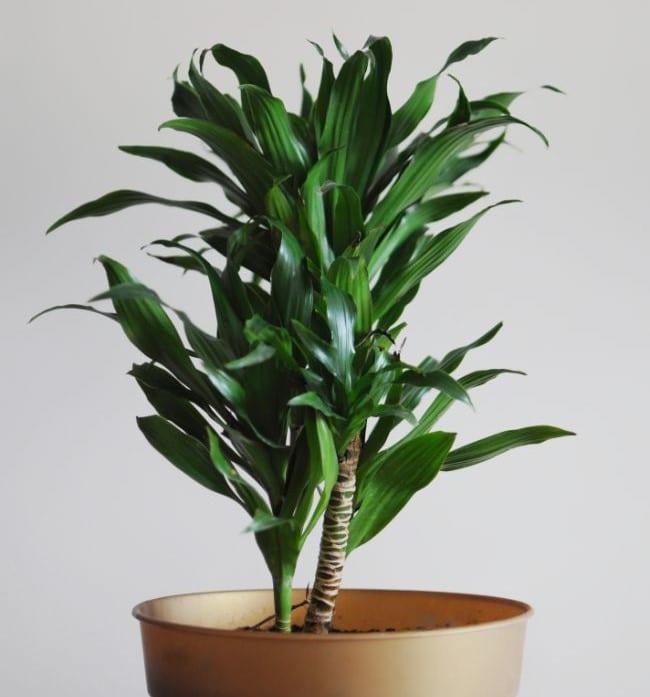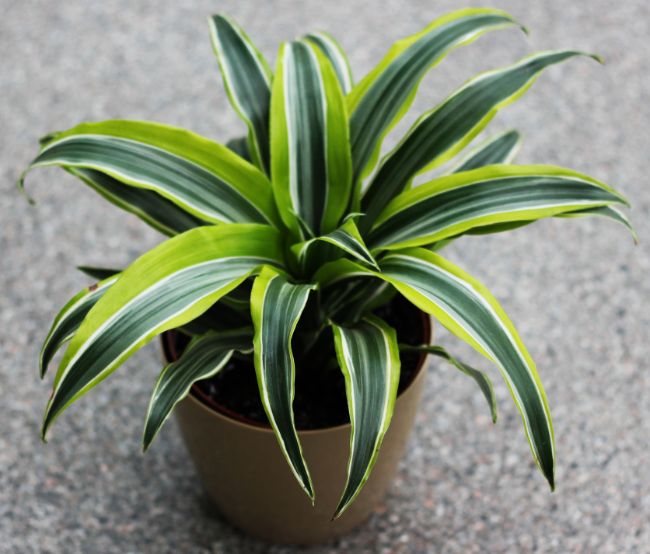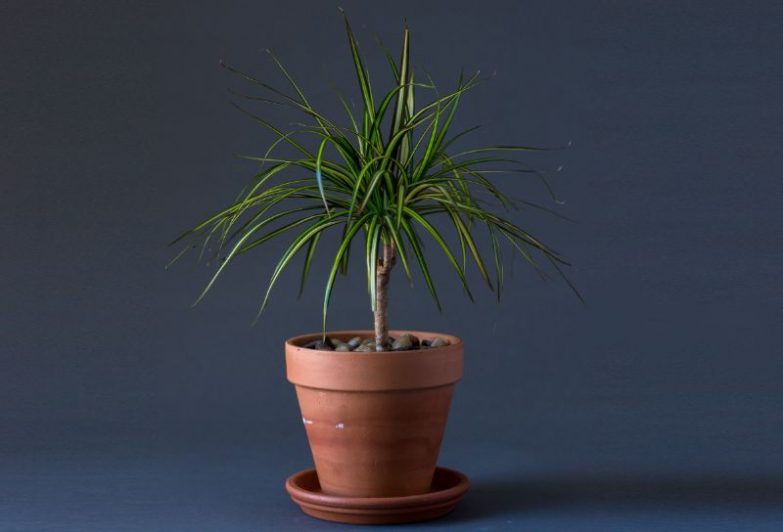Dracaena houseplants of all different varieties are grown by indoor gardeners for their attractive form and foliage, and their tolerance of a wide range of growing conditions. Whilst generally trouble-free, if you’ve noticed your Dracaena getting brown tips, you are not alone.
Dracaena houseplants most commonly get brown tips due to watering problems, over-fertilizing, or low humidity. The brown tips are caused by the leaf tissue dying in response to a lack of water or toxicity. Brown tips will not recover, but good care will prevent brown tips on new foliage.
Why Does My Dracaena Have Brown Leaf Tips?
Dracaena houseplants include the hugely popular Dracaena fragrans (Corn Plant), Dracaena marginata (Dragon Tree), and the newly reclassified Dracaena trifasciata (Snake Plant). Although they have diverse looks, they generally have similar care requirements and are susceptible to the same kinds of problems, including the development of brown tips on their leaves.
Like many plants, the first place that you will see signs of ill health is in the leaves. There are a variety of reasons that your Dracaena’s leaf tips could be turning brown and here we will look at these and recommend solutions that should quickly resolve the issues.
Watering Issues
Watering problems are the most common cause of leaf tips becoming brown and dry. Both overwatering and underwatering can cause brown leaf tips, but there are numerous symptoms you can look for to determine what the problem is.
Underwatering
If your Dracaena has brown tips, the most common cause of the issue is underwatering. Although they require less water than many other house plants, Dracaenas still don’t like to remain dry for extended periods.
You should water your Dracaena once the top two inches of soil feels dry to the touch. Poke your finger into the soil and check for moisture every few days. If the top two inches of soil feel dry then give the plant a good soaking until it is moist but not soggy.
Bear in mind that fast growth, warm temperatures, a porous pot or rootbound plant can all speed up the rate at which the soil dries out. As winter turns to spring, it’s easy to accidentally underwater your Dracaena houseplant as its water use increases.
Underwatering should be fairly easy to identify, but other symptoms you can look for include shrivelled leaves, a drooping plant, and a pot that feels very light due to the lack of water in the soil.
The most important thing to prevent this is to check your plant regularly and, if you have a tendency to forget the odd time, leave yourself a reminder to check your plants.
Repotting
If the soil dries really quickly then it could well be that it is time to repot your plant. Shake it gently from its pot, scrape away any loose or desiccated soil from around the root ball and repot to the next pot size up.
Now that you are aware of the problem and have resolved it, try to do the finger test at least once a week to ensure the plant is neither too wet nor too dry and to maintain an even watering routine.

Overwatering
Ideally, Dracaena houseplants should be grown in lightly moist, but not soggy soil. The easiest way to achieve this is to water the plant thoroughly until you see water escaping through the holes in the base of the pot.
Once you have done that, don’t water again until the top two inches of soil has become dry. You can test for this by simply poking your finger into the soil as far as your second knuckle.
If you don’t feel moisture then it is time to water again. Never leave the saucer full of water, and once you have watered then drain any excess water that may have filtered through.
If the plant is being overwatered, the leaves tend to become limp and soggy and go a yellow color. If this is the case with your plant, it may be that overwatering is what is causing the tips to go brown. Read my guide to fixing an overwatered plant for some tips to resurrect your plant and restore it to health.
The worst outcome of chronic overwatering is root rot. This is caused by soggy soil suffocating the roots, causing them to die off. Without roots, your plant is in big trouble. If you detect a mild case, you may be able to save the plant by repotting it into a new pot and fresh soil, pruning all affected roots during the process.
A Dracaena with a bad case of root rot has more than some brown tips to worry about. It may be time to admit defeat and start again with a new plant.
Water Impurities
In their natural environment, Dracaenas receive all their water needs in the form of natural rainfall. They simply have not evolved to cope with the chemicals that authorities add to the water in nearly all municipal systems.
Chlorine is the most common culprit, but fluoride is another. In the US, many water sources have been having tiny doses of fluoride added since the early 1960s.
Though these doses tend to be really small, over time they accumulate in the soil and this could have a toxic effect on your plant. Many people suggest standing the water in a bucket for twenty-four hours prior to using it on your plants. Though this will indeed get rid of chlorine, it does not lower levels of fluoride and so you will need to look for an alternative solution here.
If you have access to pure well or stream water then the problem is easily solved. If not, then you may have to consider other methods such as capturing rainwater or using bottled water. You can read my guide to the different types of water for houseplants to learn more.
Once you start using pure water the problem may not be resolved immediately because of the accumulation of chemicals in the potting soil. You can try to flush these impurities out but if the problem persists then you will probably need to repot the plant into new soil.
Perlite naturally contains fluoride, and although most is washed out after watering once or twice, you may want to use a potting mix that does not contain this product.
Overfeeding
Some chemical fertilizers are stronger than others or are higher in ingredients such as superphosphate. Choose a liquid fertilizer that is designed for house plants and opt for a balanced one. After that, it is simply a matter of making sure that you don’t feed your plant too often, or apply too much at once.
How Often Should I Fertilize?
If a plant is low on nutrients it will let you know by becoming weak and anemic looking. These plants are not heavy feeders and it is common for new gardeners to apply too much fertilizer in the belief that this will strengthen the plant.
What will instead happen, is that unused chemicals will build up in the soil and these can eventually prove toxic. One of the effects of this toxicity is for your Dracaena to develop brown tips.
Feeding your Dracaena once a month during the growing season is all that it needs. In the winter months, you can discontinue feeding altogether and your plant will remain perfectly happy.

Humidity Problems
House plants tend to like high levels of humidity and Dracaenas are no exception. When in a house with plenty of central heating or air conditioning, humidity levels can be difficult to maintain.
Low levels of humidity result in increased water loss from the stomata in the leaves of your plants. This can dehydrate the leaves faster than the roots can provide a supply of fresh water. This will result in the ends of the leaves dying and your Dracaena developing brown tips.
Thankfully, there are several fairly easy ways to increase humidity for your houseplants to prevent this issue.
Create Your Own Eco-System
If you group several houseplants together, their combined transpiration tends to create a micro-climate that helps them support one another. This may be enough to overcome a humidity shortage.
In more extreme cases, or if there is no suitable place to group plants, you can try a water tray. Fill a plant saucer with pebbles and then pour in water until the surface is just below the top of the pebbles.
Stand the plant pot back on the surface and make sure that its base is not getting wet. The evaporating water should now create enough humidity to keep the air humid and your plant happy.
Another solution is to use a humidifier to greatly improve the humidity level for your plants. Whilst highly effective, you do have to keep refilling the humidifier with water, and it will need to be cleaned on a regular basis.
Should I Cut Off Dead Tips?
A Dracaena with brown tips can make the whole plant look unsightly and gardeners have different views on this. Many like to cut off the damaged material so that their plants are an even, healthy color.
This is perfectly feasible as the brown tips are dead and serve no purpose for the plant. They can be snipped away with a pair of clean scissors, though the leaf tip will be slightly deformed.
It’s normally best not to cut into the healthy leaf tissue, but trim the brown tips, leaving a small margin of brown tissue instead. This will prevent the newly cut leaf tip from turning brown, which would only put you back to where you started.
Other gardeners are happy to leave the dead tips until the leaves are replaced naturally. On the subject of natural replacement, lower, older leaves do go slightly yellow and die off as part of the growing process.
This is perfectly normal and nothing to do with the problem we have been discussing here. These leaves can be removed by putting downwards toward the base of the plant. They should come away very easily.
In Conclusion
Whilst brown tips can be a problem, they will not do long term damage to your plant provided you take swift remedial action to prevent the problem from getting worse.
Underwatering is by far the most common cause of this problem so always check for this first. Examine the plant carefully and think about the recent care it has been getting to determine the cause.
If you’d like to be able to prevent brown tips and other common problems, and grow beautiful houseplants with ease, check out my book, Houseplants Made Easy. I cover everything you need to know to grow wonderfully healthy houseplants that will thrive year after year.

